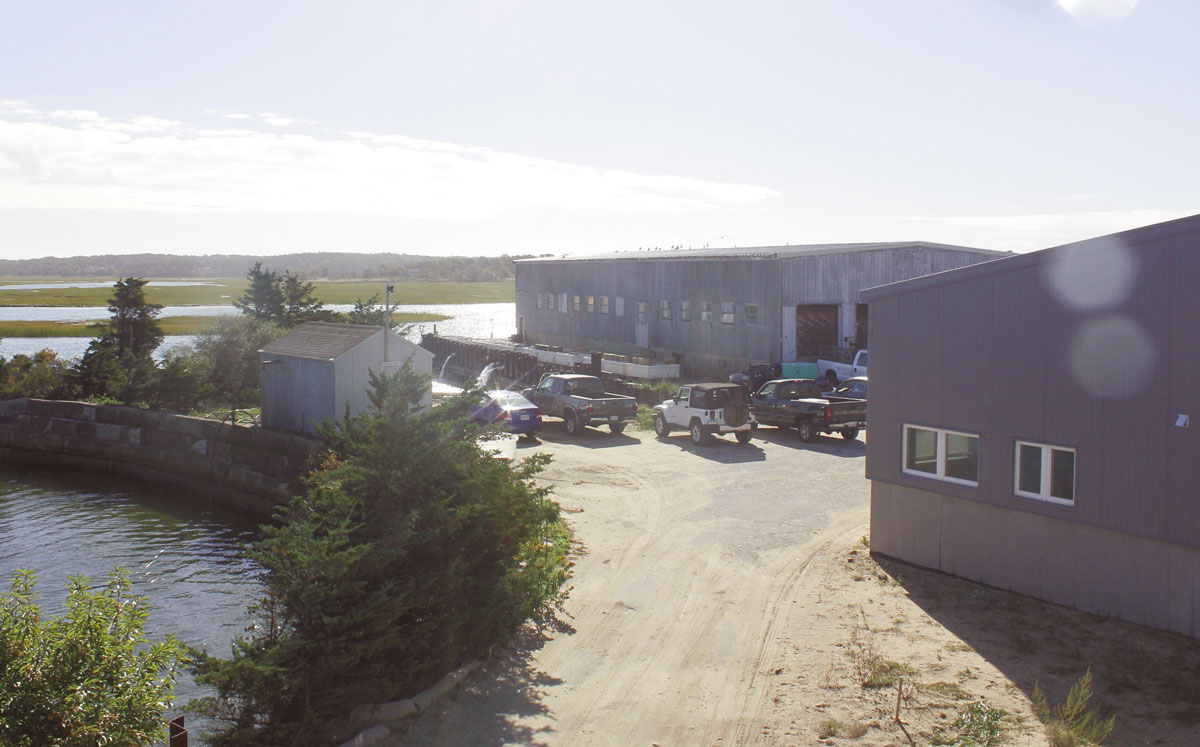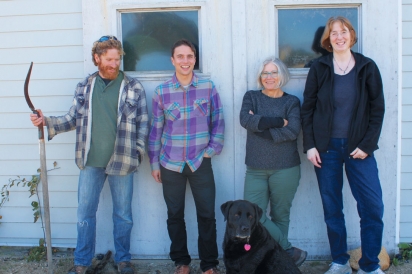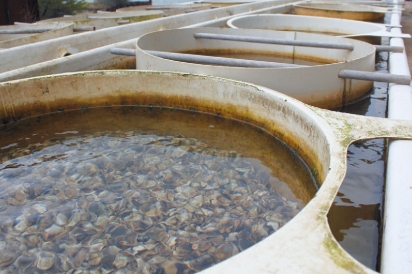The Arc
Seeding Aquaculture on the Cape
Go into any restaurant on Cape Cod and find shellfish prominently featured on the menu. Head into every souvenir shop and oysters and clams will adorn t-shirts, post-cards and jewelry. Thousands of people swarm the streets of Wellfleet for a nationally recognized festival to celebrate the oyster. The oyster and clam have become mascots for Cape Cod. People grab their dozens and slurp them down without realizing the story behind them. It took years of scientific exploration, experimentation, sweat, tears and passion to create those salty shelled delicacies, and the Aquacultural Research Corporation (ARC) in Dennis pioneered this industry for Cape Cod.
ARC is located down a long, sandy stretch off Chapin Beach Road. Most people know about ARC because they were in the news over the past few years for fighting for wind turbines, and most recently, their huge renovation and expansion. ARC is responsible for producing oyster and clam seed for farmers and researchers. They also have a distribution warehouse where they purchase shellfish from local farmers and wild harvesters to distribute nationally. ARC has grants, where they grow and sell their own shellfish. And lastly, they are responsible for a clean water restoration program with counties and towns to clean waters of excess nitrogen and algae. There is no place like ARC on Cape Cod or even in Massachusetts. Amazingly, only about a dozen people are behind this vast operation.
ARC opened in 1961. Richard (Dick) Kraus started working there in 1973. There was only a small hatchery and they weren’t producing any seed at that time. “By 1982, we were starting to produce commercial quantities of hard clams,” said Kraus. That year, they took the seed that was produced and successfully planted a million clams. By the end of the 80s they were growing 11-15 million per year. Kraus became General Manager in 1985 and held that position until 1995. At that point it was a corporation. There were several investors who began to lose interest, which is when Kraus and longtime employees Gail Hart and Sue Machie purchased ARC. They were using all of the seed to plant for themselves, but they weren’t seeing immediate income because of the length of time it took to grow shellfish. This is when they began producing seed to sell to farmers.
“Dick pioneered the idea of growing mass quantities of shellfish on beds as farms and that created a steady market, which helped increase demand for both wild and farmed product,” said current manager Paul Wittenstein. “And slowly people got into it and he really helped all those people along and helped find more people that were interested in farming. It’s exploded into this industry of shellfish farming.”
At the end of that long drive to ARC, there are old greenhouses that are falling apart, but a new, state-of-the-art, hatchery is the backdrop for these dilapidated structures. In 2015, Machie, Kraus and Hart had gotten to the point where it was time to sell ARC. The hatchery was, quite literally, falling down. You’d walk in and feel drips of water on your head from rain the night before. They hired Rob Doane who was working as financial controller for Mac’s Seafood.
“Sitting in my office at Wellfleet Shellfish Company, growers would come up to me and say ‘You have to save ARC,’” said Doane. “Eventually ARC came knocking.”
Doane is currently CEO and President of ARC. The company sold 30 out of 40 of its beachfront acres to a conservation restriction. Doane attributes Senator Dan Wolf as being instrumental in this process. The money came from Barnstable County, the Towns of Dennis and Yarmouth, Dennis Conservation Trust and The Nature Conservancy. This money allowed the old owners to hand the keys over. A corporation was formed which included individual investors as well as groups including Wellfleet Shellfish Promotion and Tasting (SPAT) and the Cape Cod Commercial Fishermen’s Alliance (CCCFA).
“An important element in the situation is that the three founders are at the end of their careers and wish to find a solution that enables them to realize cash value from the land, recruit new leadership to the business, but still preserve some role for them to contribute the knowledge and experience they have gained over 40 years. The Alliance could not allow the hatchery to close,” said CCCFA President John Pappalardo.
The new facility is capable of producing twice as much seed. Currently, seed is sold from Provincetown to Bourne, and all along the Eastern seaboard. They’re on track with last year’s numbers, which, according to Doane, is a good sign.
It’s hard to believe that many oysters consumed were once microscopic larvae and were produced in an artificial environment at ARC. Kraus hand-selected oysters and clams that are the most disease-resistant, best growing and most beautiful to spawn, known as broodstock. ARC has some oysters that are eight years old that are kept just for spawning.
Spawning usually happens mid to late winter. According to Wittenstein, each broodstock is in its own container. The technicians heat up the seawater to encourage the broodstock to ripen and release sperm and eggs.
“We basically trick those animals into thinking it’s summer,” said Wittenstein. “We recreate the situation of the tide coming in on a hot summer’s day and it gets them to spawn. When one starts spawning, the rest of the animals sense it. When one starts going, they all start going.”
Once the animals release their sperm and eggs, the technicians mix them together and put them under the microscope to see if they fertilized. Within 24 hours of a spawn, they become swimming larvae. The larvae are kept in the heated seawater, fed algae and monitored for growth every few days. After two to three weeks, they’re ready to set. The shellfish lose their swimming mechanism, or cilia, and go through metamorphosis, when they form a shell. Clams, on the other hand, keep their cilia, which to most people is known as the foot.
Once they get a to certain size and once the seawater warms up outside, they go out to the nursery, a series of upweller tanks constantly pumping in fresh water from Chase Garden Creek. ARC usually sells the smaller seed to researchers at labs, but some farmers do purchase small seed too. The larger seed is more expensive because it takes a lot of labor to grow and feed them.
“The larger it is, the less of a mortality risk the animal will have,” said Wittenstein.
Smaller growers usually purchase 10,000-20,000 seed, whereas larger farms purchase millions. ARC sells seed 1-20 millimeters in diameter.
ARC has its own field crew to plant and harvest its own oysters and clams at grants in Barnstable and Wellfleet. When the seed is ready, they plant tiny quahogs under nets, and grow and sell them at whatever size they desire. Oysters are grown in bags and hang on racks. Wittenstein said that oysters usually take a year and a half to grow to full size. Clams take two to two and a half years. Once they are ready to sell, they are stored at the warehouse and sold nationally and in Canada.
ARC sells oysters and clams to the propagation programs of towns on Cape Cod as a part of a clean water restoration project, and as a means to augment the wild fisheries. ARC sets larvae on empty shells and towns buy bags of the shells because oysters and clams filter nitrogen out of water.
“Because our waterways are nutrient loaded by septic systems and lawn fertilizers, it causes an overabundance of algae,” said Wittenstein. “It’s normally healthy algae, but when there’s too much of it, it degrades water quality. The shellfish eat that algae so that the algae population is maintained at a normal level.”
They also sell oysters and clams to towns for recreational and commercial purposes. For example, Chatham purchases them so people can make a living year round digging for clams. This is one of the many ways ARC helps with employment on Cape Cod.
“ARC supports over 1400 jobs in commercial and recreational shellfishing and the seafood industry,” said Pappalardo. “Nearly 17,000 recreational shellfish licenses are sold annually on Cape Cod and ARC supplies the needed shellfish to sustain the demand for this fishery.”
Though ARC has a new, state-of-the-art hatchery, they’re still searching for working waterfront for the nursery because they’re expanding and also because they need water at a more stable temperature. For years, ARC’s upwellers were at Stage Harbor Yacht Club, but now the club is taking that building over.
“I equate it to finding affordable housing on Cape Cod. Its the same thing,” said Doane. “We’re up against trying to find working waterfront property which is just evaporating on the Cape. Some of the year round industries are dependent on it and we’re trying to compete with millionaires from out of town.”
But no matter what, they want to be the hub for shellfish farmers and help the industry continue to grow.
“This is a way to keep fisherman who are hurting on the water make a living,” said Wittenstein. “It’s a way to keep young people who want to be here and give them something to do. There’s limited options and this is one more viable option to make a living here. If the tourism industry were to ever crash on Cape Cod, yes, we’d be hurting but we will still find the market in the cities.”
The great thing about ARC is that it is multi-faceted. Because of years of trial and error and evolution, and lots of ideas and failures, mishaps and coincidences, they have created a unique place. From start to finish, they have given birth to these shellfish, raised them and seen them off.
There are always going to be obstacles, most recently the closures of popular shellfishing areas in Nantucket Sound because of a serious virus called pseudo-Nitzschia and the closure of Wellfleet Harbor with Norovirus. Unfortunately, the closing of Wellfleet Harbor came days before the popular Wellfleet Oyster Fest, an event shellfishermen rely on as a big financial boost before winter arrives. As a result, no raw shellfish was sold this year.
“The oyster boom was due to the food and drug administration pushing all of these states to clean up their waters which happened in the 90s,” said Krauss. “Before that there was no monitoring the water quality. You could harvest anywhere, so people were getting sick, which is why people shied away from oysters. Over the next ten years, people began to realize that and the water quality was tested more frequently, which is why the oyster boom took off.”
These obstacles won’t stop them. Shellfish farming has proved to be a sustainable industry and whatever changes may happen, or evolving that needs to occur, ARC will be ready.
“In its heyday, ARC was the end-all be-all of shellfish and we would like to bring it back to that and have everyone who is in this industry be involved and prospering and having a good time, making a good living, producing good food,” said Wittenstein.






